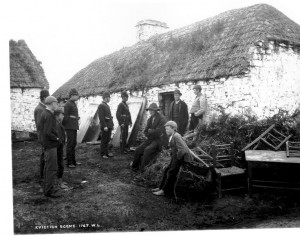Drumfries means the heather ridge. This was an important junction for people from Carndonagh and Clonmany travelling to Buncrana. People walked long distances or travelled by cart to sell coarse cloth or wool at the markets. The main townlands are large by Donegal standards.The population in 1881 is given below but figures were higher before the Famine. The townland that suffered most during the Famine was Ballinlough with the population dropping from 98 to 44. Between 1881 and 1901 the population declined by two or three persons per townland so the area was not hit by emigration at this time.
Ballinlough 938 acres …population 86
Ballintlieve 520 acres…..population 71
Carroghill 305……population 40
Glasmullan 1,075 ..population 70
Meenadiff 419…population 30
Quarries
There is a large stone quarry close to the cross roads. Men carted stone from here for road making during the Famine. Later, with the advent of the railway a siding was built to transport the stone to other areas. Over 40 men were employed here at peak times.
Landlords
 Lord Donegall was the first major landlord but when he went into debt he sold the property to Lord Templemore. About 1820, Mr. Harvey built a shooting lodge here called the Meentiaghs Lodge. He had extensive lands for shooting and hunting parties came from England. The only trees in the area at one time were planted around the lodge to encourage wildlife.
Lord Donegall was the first major landlord but when he went into debt he sold the property to Lord Templemore. About 1820, Mr. Harvey built a shooting lodge here called the Meentiaghs Lodge. He had extensive lands for shooting and hunting parties came from England. The only trees in the area at one time were planted around the lodge to encourage wildlife.
In 1878 Captain Cochrane acquired the property but later moved to live at Redcastle. When rents had to be paid in October farmers formed a queue outside the Lodge to pay their money. There were evictions here after the Land War when some tenants refused to pay. The agent was Mr Harvey of Derry who got court orders for evictions. Other landlords were Cary, Dysart and Kennedy.
Roads
The main road through Drumfries has always been well maintained because landlords needed it to travel to Buncrana and Derry. Other roads were neglected. The Grand Jury consisted of landlords and they met at Lifford and allocated money for perches of road and for bridges from the 1700s. In the 1900’s men knapped stones and were given contracts to maintain the road.
Lakes
The two lakes were famous at one time for trout and eel. Cochrane was able to use the lakes for fishing purposes when he had guests or when shooting was not seasonal.
Farming
The area always had a great reputation for growing flax because of the nature of the soil. Flax was sold in Derry or used for thatch. There were four looms in the parish and weavers could make cloth from it and bring it to the market in Derry. Nearly every house had a spinning wheel. There were no mills in the area so weavers had to go to Clonmany or Buncrana.
Shirts
The shirt factories in Derry offered employment to women. Agents travelled to Drumfries and gave out shirt parts to be sewn up at home. Drumfries was part of a network of cottage industries that flourished in the 1890s and early 1900s. Women also made money by selling eggs to the cooperative in Clonmany or at the market in Buncrana. Spinning was also a source of income as was knitting.
A famous weaver
One of the most famous weavers was Charles McGlinchey 1861-1951 whose house can still be seen in Meentiagh Glen. His father was also a weaver and both himself and his father were great storytellers, folklorists and craftsmen. A famous summer school was held some years ago and many well-known people attended such as Seamus Heaney, Brian Friel and John Hume. McGlinchey is buried in Clonmany.
National School
The old national school has been demolished.
Railways
The railway station was built in 1901 when the Buncrana-Carndonagh extension was opened. You can still see the track followed by the line and some old gate posts, level crossing cottages and bridges have survived. A fine cut-stone bridge can be seen below the cross roads. The old station is now a public house but the old Welsh brick can still be seen. The contractor for the railway was Messrs Pauling of London. The railway opened up the district and people travelled to markets, cattle shows in Carndonagh, pilgrimages to Doon Well, the Eucharistic Congress in Dublin in 1932, Clonmany races and regattas on the Swilly.
Geology
The area is rich in talc slate and quartz rock with some greenstone. The stone is valuable for construction.
Archaeology
Ballinough – The famous “White Stone” was a landmark visible from the main road along the lakes but it was removed in 1949. It was probably a standing stone. Fragments of white quartz have been noted here. The surrounding area is rich in rock art and other stone monuments. St. Maine is also connected with this place.
Ballintlieve ( the Hill of the tribe)– The “Priest’s Grave” relates to the period of the Penal Laws of the early 1700s which aimed to destroy Catholicism. Wandering friars, mostly Franciscans, travelled from place and in this spot, an unnamed friar was killed. He was a contemporary of Fr. Hegarty of Buncrana. The site was chosen because of its remoteness. There was an old graveyard at Drumaneigh.
The “Laght” consists of 12 stones in a circle. The origins are unclear but it may have been a temporary refuge or religious foundation. It was a holy place and a place of pilgrimage and it may have been a location for the burial of unbaptized children.
Glasmullan – mass site belonging to the post-1700 period. It was established when there were no local churches.



